From the towering apple trees that dot the mountain orchards to the sprawling peach groves of the Piedmont, North Carolina offers a feast for the eyes and taste buds alike when it comes to fruit trees. These trees don’t just stand around looking pretty; they work hard to produce some of the tastiest treats you can find in nature.
Imagine biting into a freshly picked North Carolina apple, its crispness and flavor bursting with the essence of the Appalachian mountains. Or perhaps you prefer the velvety feel of a ripe peach from the heart of the state, a testament to the warm sun and gentle breezes that define the Piedmont region. There are even more to choose from!
Let’s take a look at some of the best fruit trees that can grow and thrive in North Carolina’s hardiness zones!
1. Apple
Apple trees thrive in various regions of North Carolina due to the state’s favorable climate and soil conditions. The state’s diverse landscapes, encompassing mountains, piedmont, and coastal areas, create microclimates suitable for different apple varieties.
North Carolina’s climate, featuring warm summers and cold winters, aligns with the apple tree’s growth requirements. The winter chill is crucial for the trees’ dormancy period, which sets the stage for robust fruit production during warmer months. The varied elevations across the state contribute to distinct microclimates that accommodate a range of apple types, allowing growers to select those best suited to their locations.
The state’s soil diversity also contributes to successful apple cultivation. Well-draining soils in the Piedmont region prevent root saturation, while loamy soils in coastal regions provide necessary nutrients. Proper drainage prevents root diseases and promotes healthy root systems, essential for overall tree vitality.
Integrated pest management practices in North Carolina aid apple trees’ growth. Beneficial insects, such as ladybugs, are encouraged to control harmful pests, reducing reliance on pesticides. Ongoing research and extension services offer up-to-date information on disease-resistant apple varieties and effective prevention methods.
Apples are a significant crop in North Carolina. While not the largest fruit crop, they hold economic importance and a place in the state’s agriculture.
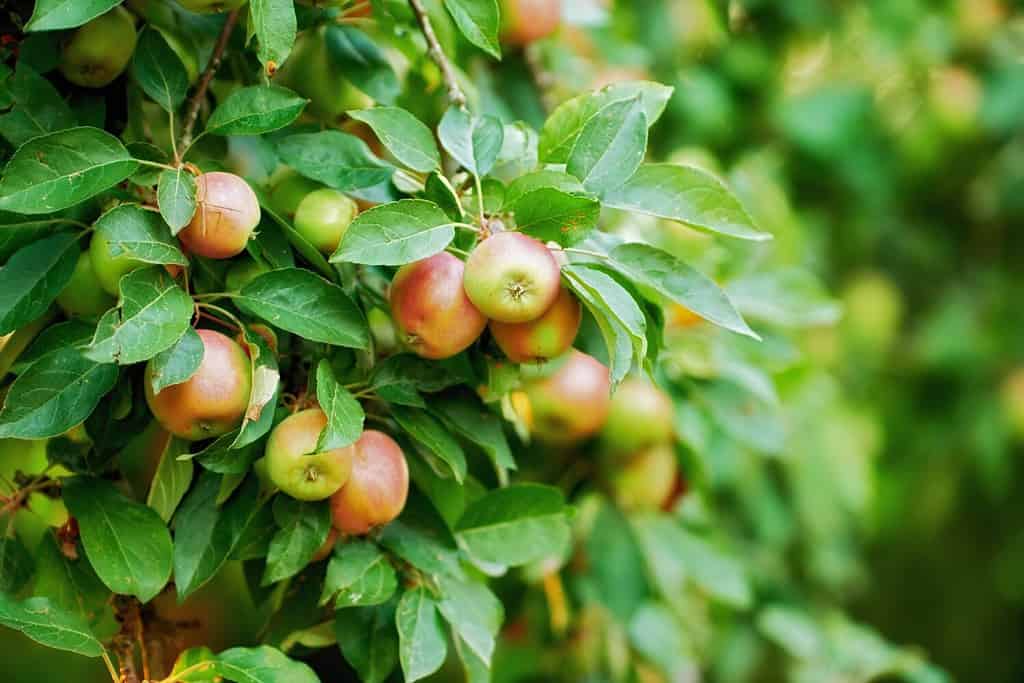
©PeopleImages.com – Yuri A/Shutterstock.com
2. Peach
Peach trees find a hospitable environment in specific regions of North Carolina, fostering their thriving growth. The state’s diverse geography, encompassing mountains, piedmont, and coastal areas, offers a range of microclimates suitable for different peach varieties.
North Carolina’s climate, characterized by warm summers and mild winters, aligns well with peach trees’ needs. These trees require a certain number of chill hours during winter to produce healthy blooms and fruits. The varying elevations across the state create distinct microclimates, allowing growers to choose peach varieties that match their specific location.
Several peach varieties thrive in North Carolina’s conditions. The ‘Cresthaven’ variety is renowned for its juicy and flavorful fruit, ideal for fresh consumption or processing. Another popular choice is the ‘Redhaven,’ famous for its early harvest and delicious taste. The ‘Elberta’ peach variety, known for its large and sweet fruit, also flourishes in the state.
Peaches are quite a significant crop in North Carolina. The state’s climate, particularly in the warmer regions like the Piedmont and coastal areas, provides favorable conditions for successful peach cultivation. North Carolina ranks among the top peach-producing states in the nation.
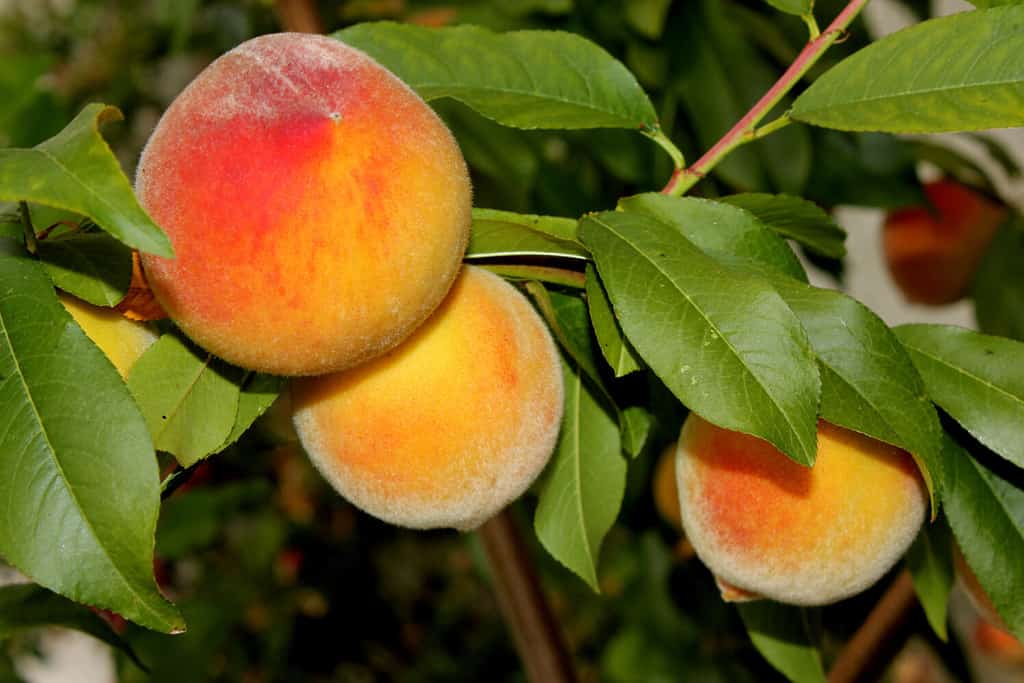
©Gurcharan Singh/Shutterstock.com
3. Pear
Pear trees are deciduous fruit trees appreciated for their delightful fruit, which comes in various shapes, sizes, and flavors. These trees are known for their distinct appearance, with oval-shaped leaves and clusters of delicate white flowers during spring. As the flowers fade, small green fruit begins to form.
Mature pear fruit varies in color, from shades of green to golden yellow, depending on the variety. The texture of the skin can be smooth or slightly rough, and it may change as the fruit ripens. When fully ripe, pears are firm yet slightly yielding to touch. Their flavor is a delightful blend of sweetness and mild tartness, making them versatile for both snacking and cooking.
In North Carolina, several pear varieties thrive due to the state’s favorable climate and soil conditions. The ‘Bartlett’ pear is a standout, renowned for its exceptional sweetness and juiciness. Its pale green skin transforms to a vibrant yellow as it ripens, and its tender flesh is perfect for enjoying fresh. The ‘D’Anjou’ pear is another successful variety, valued for its smooth texture and versatility in culinary applications. Additionally, ‘Moonglow’ pears find a welcoming environment in North Carolina, offering a distinct, mild flavor and smooth texture.

©Jennifer Bosvert/Shutterstock.com
4. Fig
Fig trees are remarkable fruit-bearing trees appreciated for their unique appearance and sweet, delectable fruit. These trees possess a distinctive look, with broad, lobed leaves that provide ample shade in warm climates. Fig trees can grow to varying heights, and their branches create an inviting canopy.
The fruit of the fig tree, known as the fig, comes in a variety of shapes and colors, including green, yellow, purple, and brown. When ripe, figs are plump and tender, with skin that ranges from smooth to slightly wrinkled. The flesh inside can be vibrant and sweet, often punctuated with tiny edible seeds that add a pleasing crunch.
Certain fig varieties thrive in North Carolina due to the state’s suitable climate and soil conditions. The ‘Celeste’ fig, also known as the “sugar fig,” is particularly well-suited for North Carolina. Its small to medium-sized fruit has a rich, honey-like flavor and a delicate skin that’s easy to enjoy. The ‘Brown Turkey’ fig is another successful variety, producing medium-sized, pear-shaped figs with a sweet and mildly nutty taste. ‘Chicago Hardy’ figs are also favored in North Carolina, known for their adaptability to cold temperatures and sweet, juicy fruit.
Despite popular belief, figs are not considered a major crop in North Carolina. While they grow well in the state’s favorable climate, fig production is relatively limited compared to other fruits like peaches and apples. Figs are appreciated by local gardeners and some small-scale farmers, but their cultivation and commercial distribution are not as widespread.

©Eric Buermeyer/Shutterstock.com
5. Plum
Plum trees are deciduous trees prized for their vibrant appearance and luscious fruit. These trees have a distinctive look, featuring round or oval-shaped leaves and delicate white or pink blossoms in spring. As the blossoms fade, small fruit begins to form, gradually developing into the plums we enjoy.
The appearance of plums varies widely among varieties. They can be round or slightly elongated, and their colors range from deep purple and red to yellow and green. The skin can be smooth or slightly textured, and the flesh inside is succulent and juicy. The taste of plums is a delightful combination of sweet and tangy, with some varieties leaning more towards one flavor aspect than the other.
Certain plum varieties thrive in North Carolina due to the state’s suitable climate and soil conditions. The ‘Methley’ plum is well-suited for North Carolina, known for its early ripening and sweet, juicy fruit. Another successful variety is the ‘Santa Rosa,’ which produces medium-sized, reddish-purple plums with a balanced sweet-tart flavor. ‘Ozark Premier’ plums also find a welcoming home in North Carolina, offering large, flavorful fruit perfect for snacking or baking.
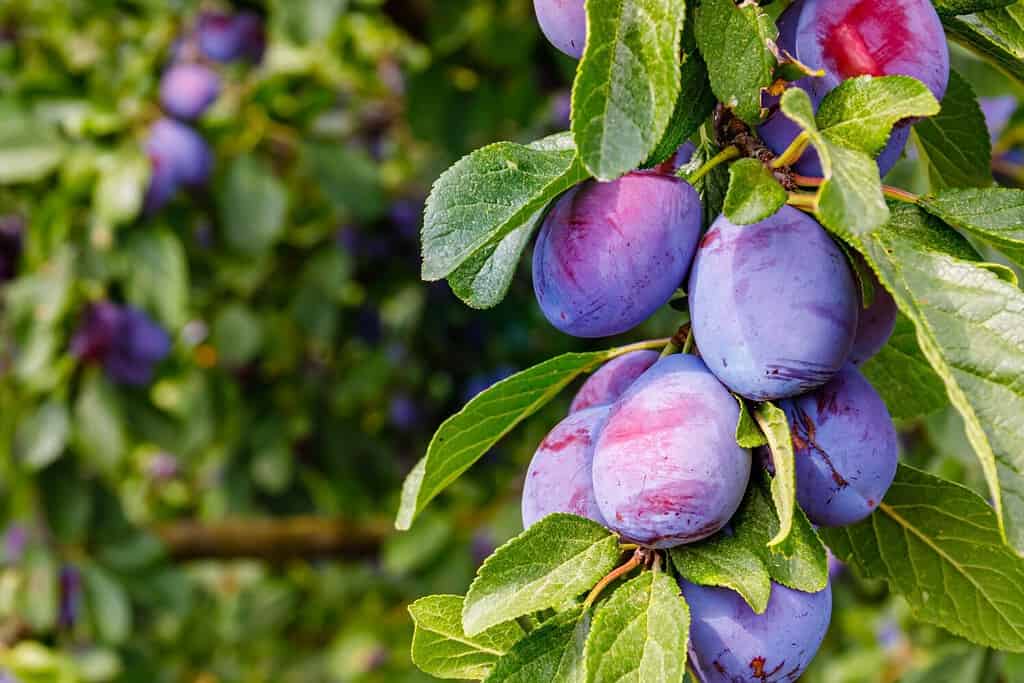
©nnattalli/Shutterstock.com
6. Cherry
Cherry trees are renowned for their captivating beauty and delicious fruit. These deciduous trees exhibit a striking appearance, with branches adorned by clusters of dainty white or pink blossoms in spring. As the flowers give way, small fruit begins to develop, eventually maturing into the cherries we relish.
Cherries come in diverse varieties, each with unique features. The fruit can be small or relatively large, with colors ranging from bright red and deep purple to golden yellow. The skin can be smooth or slightly textured, and the flesh inside is juicy and succulent. The taste of cherries is a harmonious blend of sweetness and tartness, varying in intensity among different varieties.
In North Carolina, certain cherry varieties flourish due to the state’s suitable climate and soil conditions. The ‘Stella’ cherry is well-adapted to North Carolina, celebrated for its large, dark red fruit and sweet flavor. Another thriving variety is the ‘Montmorency’ cherry, recognized for its tart taste and versatility in culinary applications, including pies and preserves. ‘Bing’ cherries also find success in North Carolina, prized for their deep red color and rich, sweet flavor.

©patjo/Shutterstock.com
7. Mulberry
Mulberry trees are unique and prolific fruit-bearing trees cherished for their distinct appearance and sweet, juicy berries. These deciduous trees boast an eye-catching look, characterized by broad, heart-shaped leaves and clusters of small, inconspicuous flowers that develop into delicious fruit.
Mulberries come in various varieties, each with its own attributes. The fruit can be black, red, purple, or even white, with shapes ranging from elongated to round. The skin can be thin and delicate or slightly thicker, and the flesh inside is juicy and succulent. The taste of mulberries is a delightful combination of sweetness and subtle tartness, which can vary depending on the variety and maturity of the fruit.
In North Carolina, certain mulberry varieties flourish due to the state’s suitable climate and soil conditions. The ‘Illinois Everbearing’ mulberry is well-suited for North Carolina, known for its consistent fruit production throughout the growing season and its sweet, flavorful berries. Another thriving variety is the ‘Pakistan’ mulberry, celebrated for its large, elongated fruit with a rich, sweet taste. ‘Dwarf Everbearing’ mulberries also find success in North Carolina, ideal for smaller spaces and producing tasty berries.
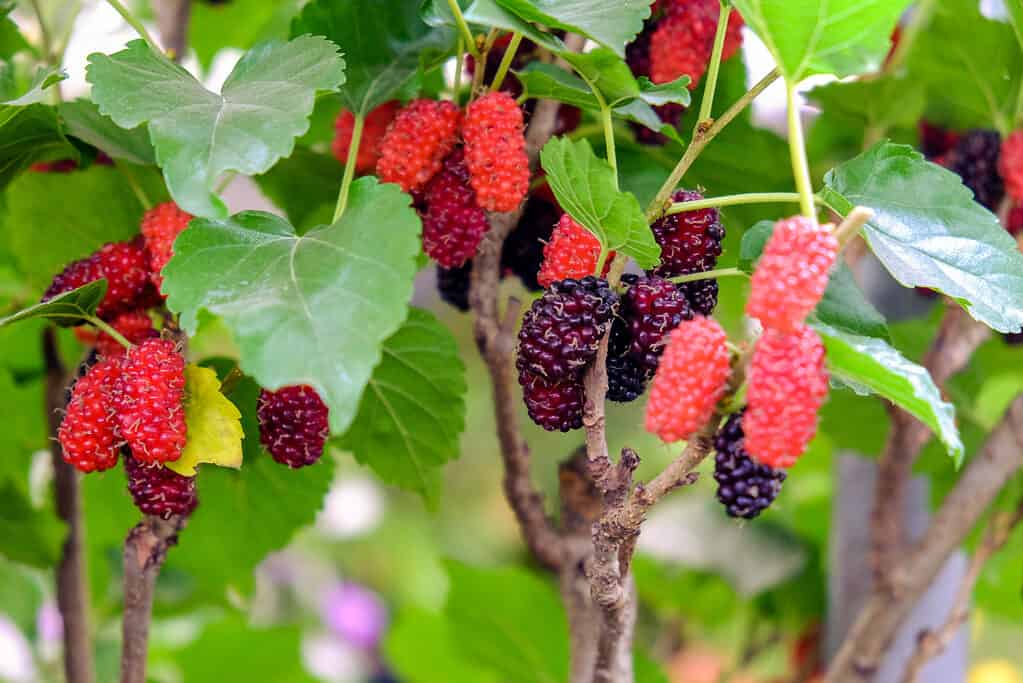
©Aunyaluck/Shutterstock.com
8. Nectarine
Nectarine trees are beloved for their unique appearance and delightful, juicy fruit. These deciduous trees showcase a distinctive look, with smooth, glossy leaves and delicate pink or white blossoms in the springtime. As the flowers fade, small fruit emerges, eventually maturing into the nectarines we savor.
Nectarines exhibit a range of colors and shapes among their varieties. The fruit can be yellow, orange, or red, with skin that’s smooth and slightly fuzzy or completely smooth like a peach. The flesh inside is succulent and juicy, often described as having a velvety texture. The taste of nectarines is a harmonious blend of sweetness and tanginess, similar to peaches but with a slightly more intense flavor.
Certain nectarine varieties thrive in North Carolina due to the state’s suitable climate and soil conditions. The ‘Redgold’ nectarine is well-suited for North Carolina, recognized for its vibrant red skin and deliciously sweet taste. Another successful variety is the ‘Sunset’ nectarine, prized for its aromatic scent and balanced sweetness. ‘Fantasia’ nectarines also find favor in North Carolina, known for their large size and mouthwatering flavor.
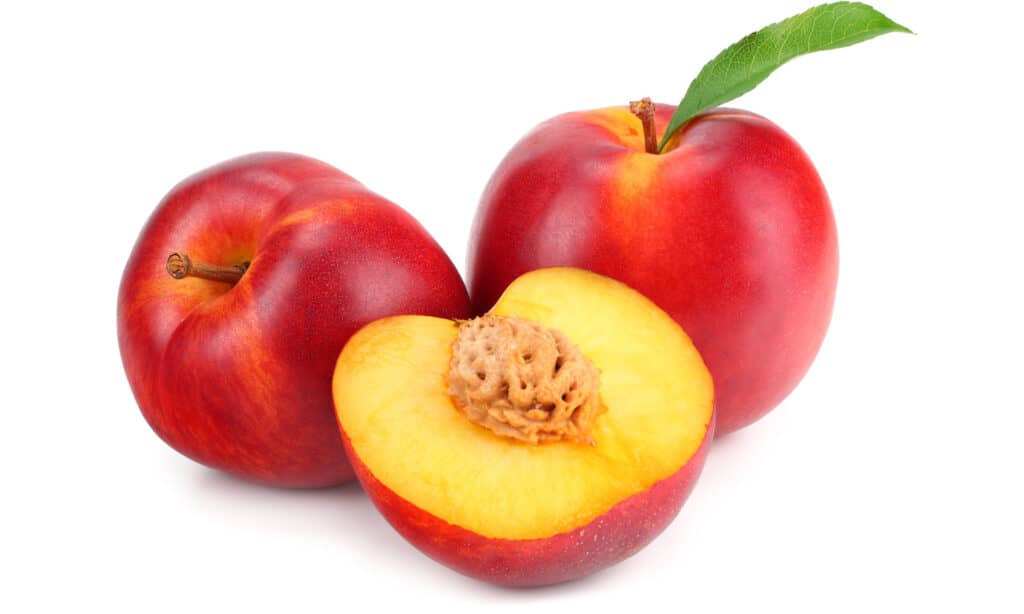
©iStock.com/Dmytro
9. Apricot
Apricot trees are cherished for their distinct appearance and delectable, tender fruit. These deciduous trees exhibit a unique look, characterized by rounded leaves and clusters of delicate white or pink blossoms in the spring. As the blossoms fade, small fruit begins to form, eventually ripening into the apricots we enjoy.
Apricots vary in color and size among their different varieties. The fruit can be golden yellow or orange, with skin that’s smooth and velvety to the touch. The flesh inside is juicy and soft, with a delicate texture that’s easily bitten into. The taste of apricots is a delightful blend of sweetness and subtle tartness, often likened to a cross between a peach and a plum.
Certain apricot varieties thrive in North Carolina due to the state’s suitable climate and soil conditions. The ‘Moorpark’ apricot is well-suited for North Carolina, known for its large, flavorful fruit that’s ideal for both fresh eating and cooking. Another successful variety is the ‘Tilton’ apricot, prized for its consistent and abundant harvests of sweet-tart apricots. ‘Harglow’ apricots also find success in North Carolina, with a balanced flavor and vibrant orange color.
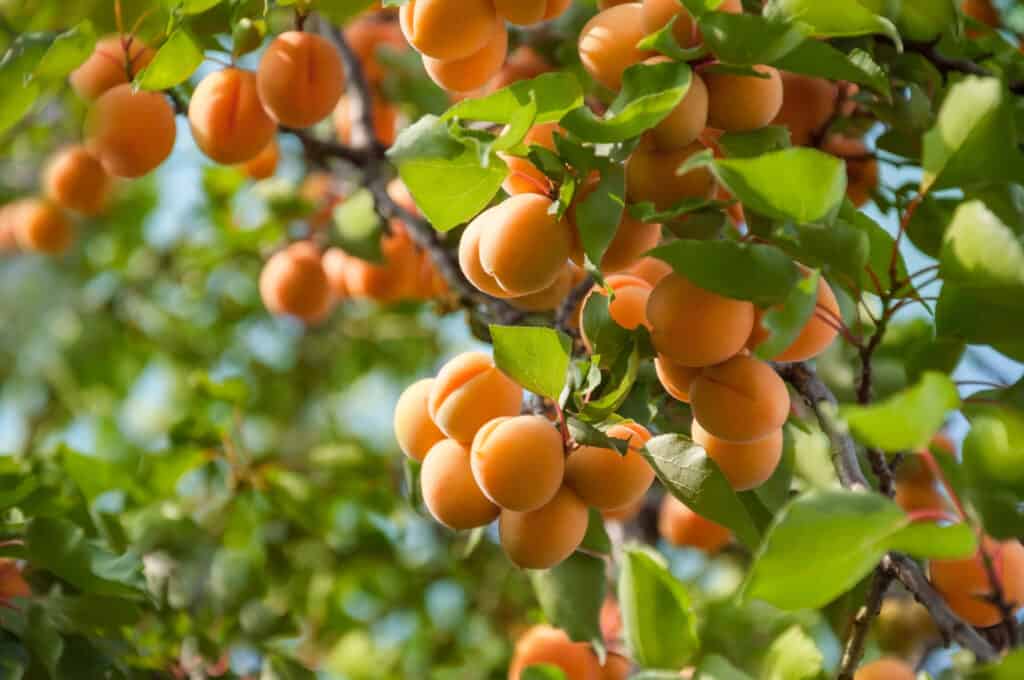
©iStock.com/Zoya2222
10. Lemon
Lemon trees are admired for their distinct appearance and zesty, tangy fruit. These evergreen trees display a striking look, with glossy, elliptical leaves and fragrant white blossoms that transform into the iconic yellow fruit we recognize.
Lemons come in various sizes and shapes, with a vibrant yellow peel that’s smooth and slightly textured. The flesh inside is juicy and tart, with a distinctively tangy flavor that adds a burst of brightness to dishes and drinks. Lemons are known for their versatility, enhancing both sweet and savory recipes.
Certain lemon varieties thrive in North Carolina due to the state’s suitable climate and conditions. The ‘Improved Meyer’ lemon is well-suited for North Carolina, celebrated for its slightly sweeter flavor and thin, fragrant skin. Another successful variety is the ‘Eureka’ lemon, prized for its large size and classic tart taste. ‘Lisbon’ lemons also find success in North Carolina, producing abundant fruit with a tangy punch.

©SNK Media/Shutterstock.com
Summary of the Best Fruit Trees That Grow In North Carolina + More Fruit Trees
| # | Fruit Tree |
|---|---|
| 1 | Apple |
| 2 | Peach |
| 3 | Pear |
| 4 | Fig |
| 5 | Plum |
| 6 | Cherry |
| 7 | Mulberry |
| 8 | Nectarine |
| 9 | Apricot |
| 10 | Lemon |
| 11 | Lime |
| 12 | Persimmon |
| 13 | Pomegranate |
| 14 | Apricot |
| 15 | Asian Pear |
| 16 | Olive |
| 17 | Pawpaw |
| 18 | Serviceberry |
| 19 | Jujube |
| 20 | Quince |
"fruit" - Google News
August 22, 2023 at 01:38AM
https://ift.tt/otiVDUq
The 20 Best Fruit Trees That Grow In North Carolina - AZ Animals
"fruit" - Google News
https://ift.tt/HPdK3oy
https://ift.tt/Dqv85R9
Bagikan Berita Ini














0 Response to "The 20 Best Fruit Trees That Grow In North Carolina - AZ Animals"
Post a Comment